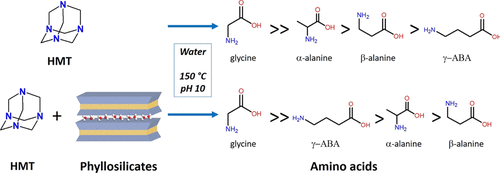当前位置:
X-MOL 学术
›
ACS Earth Space Chem.
›
论文详情
Our official English website, www.x-mol.net, welcomes your
feedback! (Note: you will need to create a separate account there.)
Impact of Phyllosilicates on Amino Acid Formation under Asteroidal Conditions
ACS Earth and Space Chemistry ( IF 2.9 ) Pub Date : 2020-07-17 , DOI: 10.1021/acsearthspacechem.0c00137 V. Vinogradoff 1, 2 , L. Remusat 2 , H. L. McLain 3, 4 , J. C. Aponte 3, 4 , S. Bernard 2 , G. Danger 1, 5 , J. P. Dworkin 3 , J. E. Elsila 3 , M. Jaber 5, 6
ACS Earth and Space Chemistry ( IF 2.9 ) Pub Date : 2020-07-17 , DOI: 10.1021/acsearthspacechem.0c00137 V. Vinogradoff 1, 2 , L. Remusat 2 , H. L. McLain 3, 4 , J. C. Aponte 3, 4 , S. Bernard 2 , G. Danger 1, 5 , J. P. Dworkin 3 , J. E. Elsila 3 , M. Jaber 5, 6
Affiliation

|
The emergence of life on Earth could have benefitted from an extraterrestrial source of amino acids. Yet, the origin of these amino acids is still debated because they may have formed prior to the solar nebula or inside the parent body of meteorites. Here, we experimentally produced amino acids by exposing an interstellar model molecule (hexamethylenetetramine) to asteroid-like hydrothermal conditions (150 °C; pH 10). We conducted additional experiments in the presence of carboxylic acids and phyllosilicates to simulate asteroidal environments. Analyses via liquid chromatography–mass spectrometry show that glycine is the most abundant amino acid formed, but non-proteinogenic α-, β-, and γ-amino acids are also produced. This production of amino acids seems to be hampered by the presence of Fe-rich smectites, while the presence of Al-rich smectites largely stimulates it. Our findings evidence (1) the production of amino acids during hydrothermal alteration of a putative interstellar precursor, (2) the importance of the formose reaction from formaldehyde and ammonia, for amino acid synthesis in meteorites, and (3) the impact of organic–mineral interactions on the nature/distribution of the amino acids produced. Altogether, the fact that the production of amino acids, which are so central to living structures, can be achieved via organo–mineral interactions under hydrothermal conditions should put these processes at a focal point for research on the origin of extraterrestrial organic compounds and into the origin of life.
中文翻译:

小行星条件下板硅酸盐对氨基酸形成的影响
地球上生命的出现可能受益于地外氨基酸。然而,这些氨基酸的起源仍在争论中,因为它们可能是在太阳星云之前或陨石母体内形成的。在这里,我们通过将星际模型分子(六亚甲基四胺)暴露于类小行星状的水热条件(150°C; pH 10)来实验性生产氨基酸。我们在羧酸和页硅酸盐的存在下进行了其他实验,以模拟小行星环境。液相色谱-质谱分析表明,甘氨酸是形成的最丰富的氨基酸,但也会产生非蛋白质的α-,β-和γ-氨基酸。富含铁的绿土的存在似乎阻碍了氨基酸的产生,而富铝蒙脱石的存在会极大地刺激它。我们的发现证明(1)假定的星际前体在水热变化过程中产生了氨基酸,(2)甲醛和氨气形成的甲醛反应对于陨石中氨基酸合成的重要性,以及(3)有机物-矿物相互作用对所产生氨基酸的性质/分布的影响。总之,在热液条件下可以通过有机-矿物相互作用实现对生命结构至关重要的氨基酸的生产这一事实,应使这些过程成为研究外星有机化合物起源的重点。生命的起源。我们的发现证明(1)假定的星际前体的水热改变过程中氨基酸的产生;(2)甲醛和氨形成的甲醛反应对于陨石中氨基酸合成的重要性;(3)有机物的影响–矿物相互作用对所产生氨基酸的性质/分布的影响。总之,在热液条件下可以通过有机-矿物相互作用实现对生命结构至关重要的氨基酸的生产这一事实,应使这些过程成为研究外星有机化合物起源的重点。生命的起源。我们的发现证明(1)假定的星际前体的水热改变过程中氨基酸的产生;(2)甲醛和氨形成的甲醛反应对于陨石中氨基酸合成的重要性;(3)有机物的影响–矿物相互作用对所产生氨基酸的性质/分布的影响。总之,在热液条件下可以通过有机-矿物相互作用实现对生命结构至关重要的氨基酸的生产这一事实,应使这些过程成为研究外星有机化合物起源的重点。生命的起源。(3)有机矿物质相互作用对所产生氨基酸的性质/分布的影响。总之,在热液条件下可以通过有机-矿物相互作用实现对生命结构至关重要的氨基酸的生产这一事实,应使这些过程成为研究外星有机化合物起源的重点。生命的起源。(3)有机矿物质相互作用对所产生氨基酸的性质/分布的影响。总之,在热液条件下可以通过有机-矿物相互作用实现对生命结构至关重要的氨基酸的生产这一事实,应将这些过程作为研究外星有机化合物起源的重点,并纳入生命的起源。
更新日期:2020-08-20
中文翻译:

小行星条件下板硅酸盐对氨基酸形成的影响
地球上生命的出现可能受益于地外氨基酸。然而,这些氨基酸的起源仍在争论中,因为它们可能是在太阳星云之前或陨石母体内形成的。在这里,我们通过将星际模型分子(六亚甲基四胺)暴露于类小行星状的水热条件(150°C; pH 10)来实验性生产氨基酸。我们在羧酸和页硅酸盐的存在下进行了其他实验,以模拟小行星环境。液相色谱-质谱分析表明,甘氨酸是形成的最丰富的氨基酸,但也会产生非蛋白质的α-,β-和γ-氨基酸。富含铁的绿土的存在似乎阻碍了氨基酸的产生,而富铝蒙脱石的存在会极大地刺激它。我们的发现证明(1)假定的星际前体在水热变化过程中产生了氨基酸,(2)甲醛和氨气形成的甲醛反应对于陨石中氨基酸合成的重要性,以及(3)有机物-矿物相互作用对所产生氨基酸的性质/分布的影响。总之,在热液条件下可以通过有机-矿物相互作用实现对生命结构至关重要的氨基酸的生产这一事实,应使这些过程成为研究外星有机化合物起源的重点。生命的起源。我们的发现证明(1)假定的星际前体的水热改变过程中氨基酸的产生;(2)甲醛和氨形成的甲醛反应对于陨石中氨基酸合成的重要性;(3)有机物的影响–矿物相互作用对所产生氨基酸的性质/分布的影响。总之,在热液条件下可以通过有机-矿物相互作用实现对生命结构至关重要的氨基酸的生产这一事实,应使这些过程成为研究外星有机化合物起源的重点。生命的起源。我们的发现证明(1)假定的星际前体的水热改变过程中氨基酸的产生;(2)甲醛和氨形成的甲醛反应对于陨石中氨基酸合成的重要性;(3)有机物的影响–矿物相互作用对所产生氨基酸的性质/分布的影响。总之,在热液条件下可以通过有机-矿物相互作用实现对生命结构至关重要的氨基酸的生产这一事实,应使这些过程成为研究外星有机化合物起源的重点。生命的起源。(3)有机矿物质相互作用对所产生氨基酸的性质/分布的影响。总之,在热液条件下可以通过有机-矿物相互作用实现对生命结构至关重要的氨基酸的生产这一事实,应使这些过程成为研究外星有机化合物起源的重点。生命的起源。(3)有机矿物质相互作用对所产生氨基酸的性质/分布的影响。总之,在热液条件下可以通过有机-矿物相互作用实现对生命结构至关重要的氨基酸的生产这一事实,应将这些过程作为研究外星有机化合物起源的重点,并纳入生命的起源。











































 京公网安备 11010802027423号
京公网安备 11010802027423号